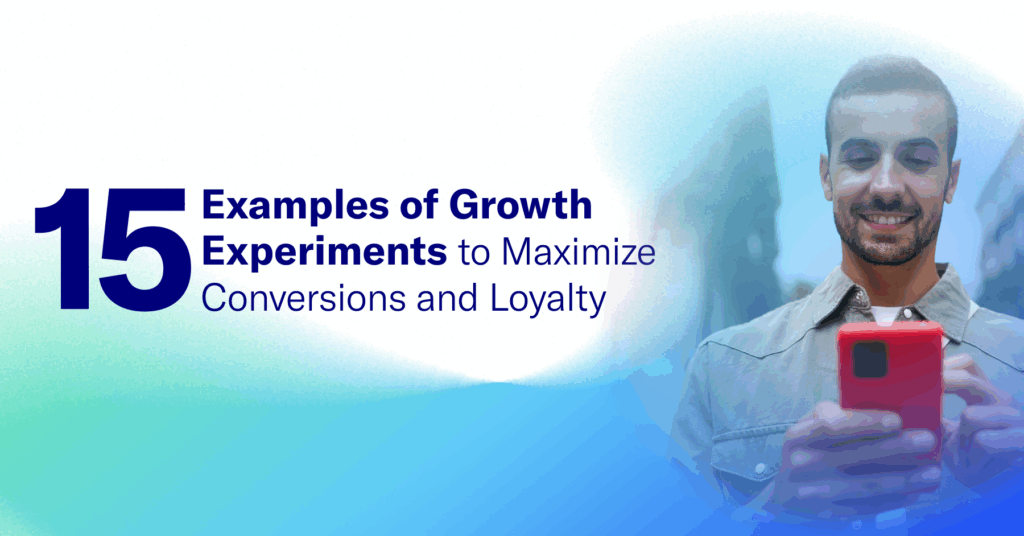15 Examples of Growth Experiments to Maximize Conversions and Loyalty

Ali Haris VP, Product Marketing, Airship

Share to my network
In this article
Categories
Book a meeting
Connect with our team of experts to discuss your conversion and loyalty goals, and how we can help you achieve them faster.
Get a demoTL;DR: Growth experimentation allows brands to test new ideas and make data-driven decisions, unlike small elements like A/B testing. This blog explores 15 powerful growth experiments and best practices for driving conversions and loyalty.
—
For years, marketers have used A/B testing to improve their messaging, design and overall user experience. They adjust headlines, change images and conduct small tests to re-engage customers. While these tests are important, they often fail to reveal larger opportunities for growth and long-term customer loyalty.
Luckily, growth experimentation takes things further by testing ideas with low risk, allowing for quick learning from the results and utilizing these insights for more informed decision-making.
In this article, we’ll share everything you need to know about growth experimentation, along with 15 powerful experiments you can try to maximize your conversions and build customer loyalty.
What Is Growth Experimentation?
Growth experimentation is a systematic approach to testing new ideas and strategies to learn what resonates with customers. Unlike A/B testing, where you can only compare one element at a time, growth experimentation offers a broader perspective by allowing you to test multiple hypotheses, understand what drives growth and design experiments to validate those hypotheses.
The core components of growth experiments are:
- A clear hypothesis: Define what you’re testing and what success looks like.
- Cross-functional collaboration: Bring together marketing, product, data and design teams to ensure alignment.
- Rapid testing & learning: Run small, controlled experiments to learn quickly and minimize risk.
- Data-driven decisions: Let insights guide your next move and continuously refine your approach.
Why Growth Experiments Matter
Growth experiments give you the confidence to make data-informed decisions, uncover hidden opportunities and optimize your customer engagement strategies across the customer journey. They let you test bold ideas without overcommitting resources, helping you see which changes actually drive conversions, retention and loyalty.
The Three Pillars of Growth Experimentation
Growth experimentation relies on three core pillars:
- Culture: Encourage curiosity and collaboration across teams to see experiments as opportunities to learn and improve.
- Process: Define your hypotheses, select measurable outcomes, prioritize high-impact experiments and document your findings.
- Skills & tools: Provide analytical skills, technical expertise and access to tools that track performance across channels.
Building an Effective Growth Experimentation Framework
Successful growth experimentation starts with a strong framework. Without structure, even the best ideas get lost, results can be unclear and opportunities for growth can be missed. A solid framework ensures you’re effectively testing the right ideas, measuring the right outcomes and optimizing for each stage of the customer lifecycle.
The 5-Step Growth Experimentation Framework
To achieve meaningful results from your tests, you need a repeatable, structured process. Here’s a five-step experimentation framework you can follow as a guide:
1. Identify Conversion Bottlenecks and Loyalty Opportunities
Start by identifying moments where customers hesitate or drift away. Whether it’s a drop in engagement or an abandoned car, these bottlenecks can indicate where growth experimentation might have the greatest impact.
2. Prioritize Your Growth Experiments
Every idea has potential, but not every idea deserves your resources right away. Focus on experiments that balance high impact with low-effort tests that can deliver quickly without major risk.
3. Create Detailed Experiment Plans
Define your hypothesis, audience, variables and success criteria before launching your experiment. A shared, detailed plan keeps everyone on the same page about what you’re testing and why it matters.
4. Implement Experiments With Proper Tracking
Accurate tracking is essential for any type of experiment. Set up the right analytics and tools you need to capture data accurately at different touchpoints.
5. Analyze Results to Inform Strategic Decisions
When the results are in, dig deep. Look beyond the metrics to understand why something worked or didn’t. Then, use these findings to keep optimizing your growth strategy until you uncover what consistently drives engagement and conversions.
15 High-Impact Conversion and Loyalty Growth Experiments
Growth experimentation is only as powerful as the tests you run. These 15 growth marketing experiments can help you identify what really drives conversions and keeps customers coming back—no matter where they are on their journey.
Conversion Rate Optimization Experiments
Conversion rate optimization (CRO) experiments focus on improving the actions customers take on your website or mobile app. These experiments help you understand what motivates users to take action and engage more with your brand.
- Value proposition refinement test: Experiment with different messaging or offers to learn which version communicates your brand’s value.
- Social proof optimization: Test testimonials, reviews or user-generated content to see how word of mouth influences your conversions.
- Form optimization experiment: Evaluate your form format and field order to minimize friction points and increase completion rates.
Checkout and Purchase Experiments
When a customer is ready to make a purchase, you don’t want any small points of friction standing in the way. Running experiments in the purchasing stage can help you identify the changes you need to make to increase completed purchases and improve the overall buying experience.
- Checkout flow simplification: Test the checkout process by removing or combining any unnecessary steps. A smoother flow can reduce friction and boost conversion rates.
- Payment options experiment: Give customers alternative payment methods such as Apple Pay, third-party financing plans or one-click checkout to see which one drives more conversions.
- Urgency and scarcity testing: Introduce limited-time offers, low-stock notifications or countdown times to encourage customers to complete their purchases.
Customer Onboarding Experiments
The first experience a customer has with your product or service sets the tone for their entire journey. Optimizing the onboarding experience can help you quickly understand what matters most to your customers and what doesn’t.
- Onboarding experience optimization: Test different onboarding flows to see which approach helps customers complete actions faster and reduces early churn.
- Welcome sequence personalization: Experiment with personalized welcome messages based on customer segments or behaviors to make your brand feel more relevant and engaging from the very start.
- User education format experiment: Try different formats for tutorials or guides through videos, interactive checklists or emails to discover what helps your customers learn about your product most effectively.
Customer Retention and Loyalty Experiments
Keeping your existing customers engaged is often more profitable than acquiring new ones. Experiments focused on retention and loyalty help you identify strategies that keep customers coming back.
- Loyalty program structure test: Test different loyalty program structures to see which design increases engagement and loyalty.
- Re-engagement campaign experiment: Try to re-engage inactive customers by testing different messages, timing and channels to rekindle interest in your brand.
- Feedback implementation loop: Experiment with gathering feedback at different touchpoints and using it as a guide to shape the customer experience.
Advanced Conversion and Loyalty Experiments
Once you’ve identified what keeps customers coming back, advanced experiments can help you uncover deeper opportunities for growth and strengthen your customer loyalty over time.
- Personalization depth testing: Experiment with personalization at various touchpoints by using customer data and behavior to see what drives higher conversions.
- Cross-selling and upselling algorithm test: Test different algorithms and sales approaches to see which increases the average order value without harming customer satisfaction.
- Customer success touchpoint experiment: Evaluate the timing, messaging and formatting that customers respond to most positively with your customer success team.
Measuring Growth Experiment Success
Running growth experiments is only valuable if you track and measure their success. Tracking the right metrics and ensuring your results are statistically reliable can turn your insights into informed decisions that improve conversions and loyalty.
Key Metrics to Track
To understand the effectiveness of your growth experiments, focus on metrics that tie directly to business outcomes. Some important ones include:
- Conversion rate: Measure the percentage of users completing a desired action, like signing up, making a purchase or subscribing.
- Customer retention & churn: Track how experiments affect ongoing engagement and loyalty.
- Revenue impact & customer lifetime value (CLV): Assess the long-term financial effects of your experiments.
- Engagement metrics: Monitor interactions like email opens, click-through rates, app sessions or feature usage to see which changes resonate most with your audience.
Statistical Significance and Sample Size
Make sure you have a large enough sample size to ensure your growth experiments are statistically reliable. A proper sample size can help you make confident decisions and avoid costly mistakes.
Building a Successful Growth Experimentation Culture
Building a thriving culture of growth experimentation takes intention and consistency. When your team values testing, learning and iterating, you can uncover faster insights and make smarter decisions together to drive conversions and loyalty.
Create a Dedicated Growth Team
Set up a cross-functional team responsible for planning, running or analyzing experiments. These can be members of your design, marketing, product or data team to ensure alignment and faster execution.
Celebrate Learning, Not Just Wins
Encourage your team to view experiments as learning opportunities. Not every test will produce a positive result, but every result provides insights that refine your customer engagement strategy.
Develop a Growth Experimentation Tracker
Keep track of all your experiments in a central tracker. Document hypotheses, expected outcomes, results and insights for each task to keep a pulse on your team’s progress.
Common Growth Experimentation Pitfalls to Avoid
Even the best growth experiments can stumble if common issues aren’t addressed. Avoid these pitfalls to make your experiments more effective and actionable:
- Running a test without a clear hypothesis: Testing without a clear goal or expected outcome leads to inconsistent results.
- Neglecting cross-functional collaboration: Working in silos limits insights and reduces impact.
- Focusing on vanity metrics: Clicks and open rates alone don’t tell you whether an experiment truly drives revenue.
- Running too many experiments at once: Overloading your growth experimentation teams can dilute focus and make it difficult to understand what’s driving results.
- Failing to iterate: Growth experimentation is continuous—not one and done.
Knowing these pitfalls, you can ensure your growth experiments produce meaningful insights for the customer journey.
Power Your Growth With Smarter Experimentation
Don’t let guesswork and simple A/B testing hold back your customer engagement and conversions. With a structured growth experimentation approach, you can test bold ideas, uncover what truly drives customer engagement and make informed decisions backed by real data. Contact Airship today to get started.
Growth Experimentation FAQ
What Is a Growth Experiment?
A growth experiment is a structured test designed to improve key business metrics like engagement or conversions. Unlike traditional marketing tests, growth experimentation focuses on uncovering what drives growth at each stage of the customer lifecycle.
What Are Some Examples of Experimentation?
There are several examples of growth experimentation at different stages of the customer. These include:
- Conversion-focused experiments: Testing landing pages, CTAs or sign-up flows to increase conversions.
- Loyalty-building experiments: Experiment with personalized offers, loyalty programs or re-engagement campaigns.
- Simple vs. complex experiments: Start with small, quick A/B tests, then move on to testing multiple channels or touchpoints of the customer journey.
What Is the Roadmap for Growth Experimentation?
The successful roadmap to growth experimentation is to build a framework, identify what types of experiments to perform, track your results and optimize often.
Key Takeaways
- Growth experiments uncover what truly drives conversion and loyalty.
- Test strategically across different areas like conversion rate, checkout, onboarding and retention.
- Track meaningful metrics like conversion, retention, revenue and engagement to guide decisions.
- Build a growth experimentation culture that iterates, documents and acts on insights.